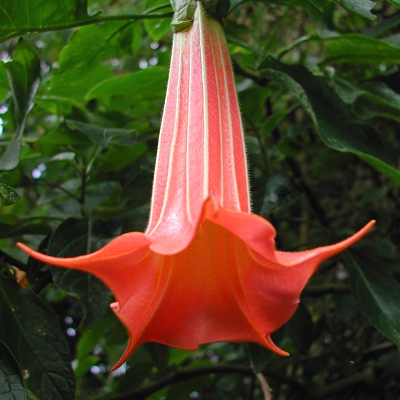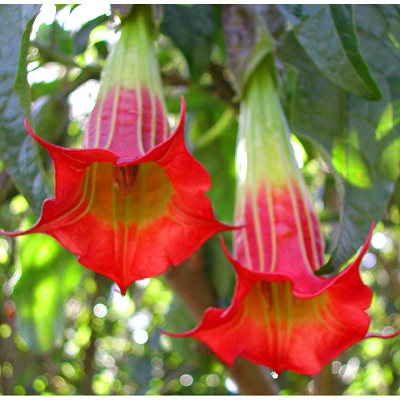Brugmansia "Vulsa" x B. sanguinea
Your seeds should be planted when received for best results. Getting started -- Soak your seeds in a cup of water for 12-18 hours (not more than 36 hours). Use containers at least 2 inches (5 cm) tall
with drainage holes. For soil, use a well draining mix. I use a mix
of 1 part
coir fiber Place a seed in each pot and cover with 1/2 inch (13 mm) of soil. Water the soil until it is evenly moist (but not saturated). The best temperature for germination is between 66 to 77° F (19-25). Nights cooler than this are ok. Avoid temperatures
above 80° F (27°C). I recommend placing a minimum/maximum thermometer Until they sprout, keep the soil surface moist. Keep the pots in an area with some air circulation, to prevent stem rot later on. Most of the seeds should start sprouting within 2-4 weeks, but some may take up to 2 months. Once they sprout, give them bright light, but shade them from strong afternoon sun. Occasionally a seedling may not shed its seed coat after it emerges from the soil. If the seed coat doesn't fall off by itself after 2 days, try to gently pry it apart with your fingernails, tweezers, etc. Growing onward.. Watering -- Aim to keep the soil evenly moist most of the time. Don't let the soil
dry out completely, but also avoid keeping it soggy. If you're unsure if
the soil down in the root zone has the right moisture, consider using a moisture meter Fertilizing -- Like other Brugmansias, this one likes regular feeding. Feed about every 2 months with a general-purpose fertilizer that contains micronutrients (I use this one). Avoid feeding if your plant goes through a period of slow growth, like during hot or cold temperatures. It's normal for an older leaf to occasionally turn yellow and drop, but if it seems excessive, the soil may be too dry down in the root zone. If you are certain the soil is moist, the plant may need more nitrogen fertilizer. If the new growth turns yellow with green veins, the pH of your soil or water is probably too high (alkaline). Try using a citrus fertilizer if this occurs, or switch to bottled water or rainwater. Transplanting - When your seedlings are about 4-6 weeks old, repot to containers about 1 quart (1 liter) in size, and then on to 1-2 gallons (4-8 liters) a few months later. It's a good idea to water the soil before repotting, to keep the soil ball from breaking apart, which can damage the roots. Wait until your plants are 15 inches (35 cm) tall before planting them in the ground (in suitable climates). If you plan to keep them in containers indefinitely, the final size of the pot will depend on how large you let your plant grow. A full-size tree may need a very large pot! You may prune your plants to any size that is convenient. Lighting -- Dappled sun or morning sun is usually best. Protect the plants from strong afternoon sun, especially in warm climates. They can take full sun in cool climates like coastal California, but they will need more fertilizer and water. Climate -- This Brugmansia is happiest with temperatures below the low 80s (28°C), and nights that are cool (below 65°F / 18°C). It might not thrive in consistently hot conditions, particularly if nights are warm. It can probably survive a few degrees of frost, but i recommend protecting it from freezing temperatures. Over about 40% humidity is best. Over about 40% humidity is best. Indoors, if your plants seem to suffer from low humidity, consider using an ultrasonic room humidifier. Pests -- Watch for any pests that can affect your other plants. Try using insecticidal soap before using stronger remedies, since some may harm the plant. If you have any questions or problems, feel free to contact me. Have fun growing them! - Jeff Strange Wonderful Things
|
|||||||||



